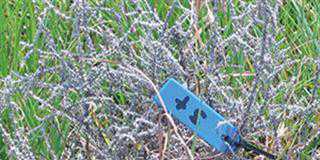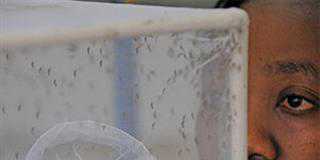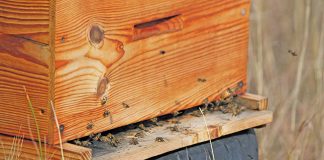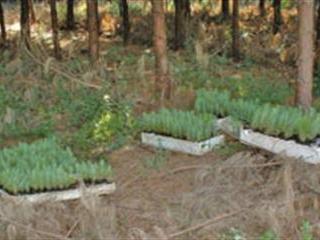
In the South African commercial forestry sector, the vast majority of income is earned at rotation-end, from products such as saw-timber, pulp-wood, veneer and mining timber. However, production cycles are long, running from seven to 25 years depending on the site, end objective and species. This is why optimising tree survival, growth and uniformity is essential to profitability, and will improve the quantity and quality of end products. As such, the industry has invested a lot of research and resources into understanding species, site matching, improving genetics and developing best management practices.
Better Planting, higher survival
Mistakes made in silvicultural management, especially during the transplanting stage, can have a lasting negative impact on the mature trees’ growth and yield. The problem for foresters, however, is that they can’t just uproot underperforming trees and replant without incurring massive financial losses. This is why Dr Keith Little insists: “Seedling quality and the transplanting operation are crucial to ensuring adequate tree survival and performance.”
Dr Keith Little
Speaking at an NCT Forestry Co-operative Field Day, he explained: “Poor tree survival due to poor transplanting practices has huge and long-term consequences for the forest industry as a whole. Even though we understand this, plantation stands with stocking levels up to 30% below optimum still occur. There should be no room for error.”
Dr Little says that in commercial forestry, the planting operation is critical for seedling survival. Barring catastrophies such as wildfire or pest and disease outbreaks, the highest incidence of mortality occurs within a relatively short time-frame after transplanting – typically one to two years depending on the tree species. As Dr Little points out, you can work with a live tree to improve its production, but a dead tree is useless.
Start in the nursery
Optimum seedling quality will ensure the best chance of survival when transplanted into a commercial forestry block. Dr Little’s first tip for foresters is to get hold of the seedling nursery’s optimum plant quality specifications. These will vary between nurseries, but should be based on credible scientific research. A nursery’s seedlings should meet these criteria. For example, seedlings ready for transplanting should be considered ‘prime’ for the size of the container within which they’ve been planted.
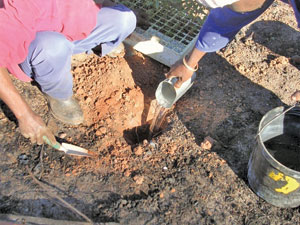
Research shows that planting a seedling directly into 1l to 2l of water applied into the planting pit, a technique called puddle planting, is optimal for its survival.
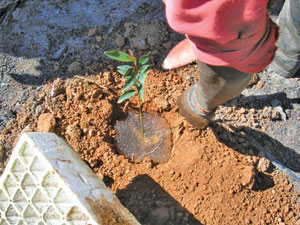
A tree seedling’s root plug surrounded by a hydrogel. A hydrogel enhances the chances of survival under high-risk conditions, such as unseasonal planting and during hot and dry periods.
Dr Little is adamant that a seedling that’s too large (over-prime) or too small (under-prime) for that specific container type or volume must not be transplanted. It will be at greater risk of dying or under-performance, hampering the enterprise’s profitability.
Dr Little explains that this is because the greater the root to shoot ratio at transplanting, the better the chance of a seedling’s survival (see Table 1).
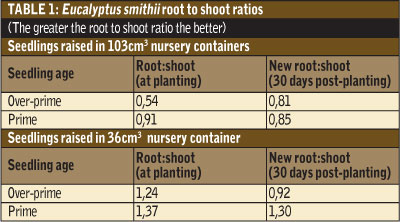
Information courtesy of ICFR
“An over-prime seedling will have been left too long in its nursery container, resulting in more stem growth relative to root growth. The root plug becomes ‘root-bound’, so that seedlings are difficult to remove from the nursery containers and the risk of damage is increased. “In addition, once the seedling is transplanted, its root growth will be reduced, compromising its ability to meet its own above-ground nutrient and moisture needs,” he explains.
“Meanwhile, a seedling considered under-prime will be more susceptible to heat stress as the root plug can’t be planted deep enough. The stem will be soft, increasing the likelihood of damage from insect pests, and the unconsolidated root plug is likely to disintegrate during transplanting.” Care when transporting commercial seedlings from nursery to field, as well as within the field, is also necessary for improved post-planting survival. Also, do not stack seedling trays on top of each other as this can bend or break the young plants.
Bending seedlings can damage their internal tissue and, as with broken stems, means the plants’ resources will be used for repair rather than growth. This is a particular problem at this stage, as growth is especially critical immediately after the seedling is transplanted. Once at the site, Dr Little urges that seedlings be kept in the shade and watered regularly until they’re transplanted from their nursery container.
Remove seedlings carefully from their trays and place them equally carefully next to pre-prepared planting pits, rather than throwing them down. Minimise the time between placement and planting, or the seedling and its root plugs will bake in the sun, lowering its ability to withstand transplant shock.
Water rules
“There have been many trials to determine the effect of planting pit size, water quantity and water application method on post-transplanting survival,” says Dr Little. “While we’re not certain of the exact role that water plays in the transplanting operation, we feel that it might reduce post-planting stress, provide moisture to initiate in-field growth, reduce soil temperature, improve root-plug-to-soil contact, and allow foresters to apply pesticides in solution to the root zone, among other things.”
Dr Little says that simply ensuring that a seedling’s root plug is wet at planting minimises immediate post-planting stress (see Table 2). This gives foresters at least three days’ grace if seedlings weren’t planted with water in the pits and/or there was no rain in the few days immediately after transplanting.To increase survival during the first week post-transplanting, foresters should plant seedlings with wet plugs and ensure there’s water in the pits.
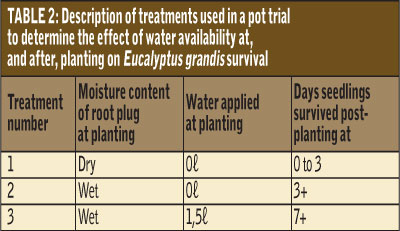
Information courtesy of ICFR
“Historically, forestry companies may have applied up to 5l to 7l of water to each seedling at planting,” says Dr Little. “But research shows that planting a seedling directly into 1l to 2l of water applied into the planting pit, a technique called puddle planting, is optimal for its survival. Using more water is a waste. “It’s also inappropriate to apply water to the soil surface around the seedling as a drench following planting, as some of it will evaporate and won’t reach the root plug zone where it is needed.”
A number of eucalypt trials showed a consistent and significant improvement in post-transplanting survival when using puddle planting and/or hydrogels. Using a hydrogel further enhances the chances of survival under high-risk conditions, such as unseasonal planting during hot and dry periods.
If you’re using a hydrogel as opposed to water during in-field transplanting, Dr Little recommends applying it into the planting pit immediately before the seedling is transplanted. Either place the seedling’s root plug directly into the hydrogel or pour hydrogel around the root plug before the soil is replaced in the pit. Don’t mix the hydrogel with the soil as this will distribute it well away from the root plug.
Planting Pits: dig in deep
In commercial forestry, preparing a planting pit is a separate operation from the actual planting. Dr Little says that for seedling survival, planting pit depth is more important than width. It’s important that the seedling’s root plug is planted deep enough, away from the hot soil surface. Soil in the planting pit should be friable and free of foreign objects, including old roots and stones, that will obstruct root-to-soil contact.
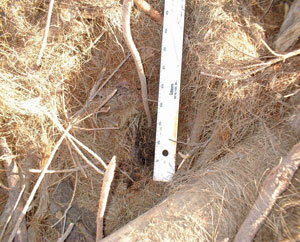
An undesirably clogged in-field plant pit. Plant pits should be totally clear of foreign materials, such as roots and stones, to improve a seedling’s root-plug-to-soil contact.
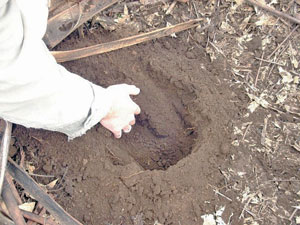
The soil in a plant pit should be friable. Clear the surface area surrounding the pit, where you can store the soil that will be used to back-fill the pit once the seedling is transplanted.
Failure to prepare a suitable quality pit will slow down the transplanting operation, as the transplanter will need to correct any quality issues. A less dedicated transplanter may simply plant a seedling in an incorrectly prepared pit, significantly reducing its chances of survival. “Ensure the area immediately around a planned planting pit is properly cleared of any slash material and weeds before the pit is even prepared,” advises Dr Little. “Not only will this allow you to dig a good quality pit, it will also create an area where you can place the soil removed when planting the seedlings until you use it to backfill around the plant.
“Planting into freshly dug pits also improves post-transplanting survival because the soil is more friable and, if you’re dry-planting, moisture content will be higher.” Dr Little concludes, “Properly training and monitoring planting staff, as well as quality control along all aspects of the planting chain, are critical if a forest company wants enough trees at harvest to make money. Getting the seedling establishment phase right is a major step in the right direction towards having enough good quality trees to harvest at the end of a cycle.”
Dr Keith Little would like to acknowledge the contributions of his ICFR colleagues, Paul Viero, Dr Carol Rolando and Dr Marnie Light towards the content of this article. Contact Dr Keith Little on 033 386 2314, email [email protected] or visit www.icfr.ukzn.ac.za. For further queries email Dr Marnie Light, head of the Regeneration Research Project at the ICFR, at [email protected].











